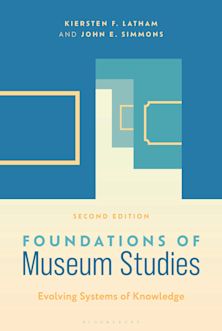How to STEM
Science, Technology, Engineering, and Math Education in Libraries
How to STEM
Science, Technology, Engineering, and Math Education in Libraries
This product is usually dispatched within 3 days
- Delivery and returns info
-
Free US delivery on orders $35 or over
Description
During the past few years, groups like the President's Council of Advisors on Science and Technology, Center for Education have been placing great emphasis on the significance of STEM (science, technology, engineering, and math) education. In brief, the US is seen as falling behind the rest of the world in science and technology education. In response, the curricula have been revised in many educational institutions and school districts across the country. It is clear that for STEM to be successful, other community organizations, most particularly libraries, need to be closely involved in the process. Library staff realize the importance of getting involved in STEM education, but many have difficulty finding comprehensive information that will help them plan and successfully implement STEM direction in their organization. This book is designed to meet that need. It is timely and relevant. How to STEM: Science, Technology, Engineering, and Math Education in Libraries is by and for libraries who are involved in contributing efforts into advancing these subjects. It is organized in 9 parts including funding, grant writing, community partnerships, outreach, research, and examples of specific programming activities. Authors are drawn from the professional staffs of educational institutions, libraries, and non-profit organizations such as science museums.
The book contains eight parts, each emphasizing a different aspect of how to succeed with STEM. Part 1 emphasizes how hands-on activities that are both fun and educational can be used to further STEM awareness. Parts 2 and 3 contain chapters on the uniting of STEM with Information Literacy. Innovative collection development ideas are discussed in Part 4 and Part 5 focuses on research and publishing. Outreach is the theme of Part 6 and the programs described in these chapters offer an array of ways to connect with students of all ages. The final section of How to STEM: Science, Technology, Engineering, and Math Education in Libraries addresses the funding of these programs.
Librarians of all types will be pleased to discover easy-to-implement suggestions for collaborative efforts, many rich and diverse programming ideas, strategies for improving reference services and library instruction to speakers of English as a second language, marketing and promotional tips designed to welcome multicultural patrons into the library, and much more.
Table of Contents
Foreword
Paula M. Storm
Preface
Vera Gubnitskaia and Carol Smallwood
Acknowledgements
Part IRange and Scope
WonderWorks: Preschoolers Playing with STEMCarissa Christner
Creating STEM Kits for Teen ProgramsKelly Czarnecki
Digging into Reading: A Worm’s PerspectiveBarbara Fiehn and Jeanine M. Huss
The Maker Movement, STEM and Libraries: How Libraries Large and Small Can Support Hands-On Math and Science Learning in Their CommunitiesCynthia Houston
The STEM Kids Program and the FIRST® LEGO® League (FLL®) at the Grand Forks Public LibraryAaron Stefanich and Laura Munski
Part IITeaching
Animation Programs at the Evansville Vanderburgh Public LibraryMichael Cherry
How Not to Blow Up the Library: Planning and Facilitating a Homeschool Science Lab in Your BuildingFred Kirchner
Customizing the For-Credit Information Literacy Course for STEM MajorsRosalia Petralia and Kathy Turner
Part IIIInformation Literacy and Educational Support
Kid-ventions with the U.S. Patent LibraryBarbara J. Hampton
A Math Emporium ProjectNastasha Johnson and Tiffany B. Russell
The School Librarian Role in the FIRST® LEGO® League Team ProjectKarla Steege Krueger
STEMming From Scratch:STEM Library Services for High School Students Enrolled as University Students
Janna Mattson and Heather Groves Hannan
Part IVCollection Development
How to Get Science GoingKeary Bramwell
Graphic Novels Ignite Imagination in the SciencesMelanie E. Hughes and Gary Pinkston
Part VResearch and Publishing
Showcasing Scientific Research Output: New Audiences for Science LibrariesAlvin Hutchinson
Embedding Librarians into the STEM Publication ProcessAnne Rauh and Linda M. Galloway
Part VIOutreach
How NOT to Reinvent the STEM Wheel: Using Crowdsourcing and Community Partners Jennifer Hopwood
Girls’ Night Out: STEM Programs for Girls OnlyKathleen J. Clauson
Celebrating Geographic Information Systems through GIS Day @ Your LibraryCarol Patterson McAuliffe
Fun is Learning: Making an Interactive Science Café SeriesKaren Lauritsen
Part VIIPartnerships
How to Make Library Workshops Popular with Science and Engineering Students Giovanna Badia
Learning About Future Stem CareersEileen G. Harrington
‘Take it from the Top’: Cultivating Relationships with STEM Faculty to Connect with StudentsShawn V. Lombardo and Barbara A. Shipman
Part VIIIFunding
Grant Writing to Support STEMSusan P. Cordell and Reenay R.H. Rogers
STEM on a Budget!Sarah Wright
About the Contributors
Index
Product details
| Published | Dec 05 2013 |
|---|---|
| Format | Paperback |
| Edition | 1st |
| Extent | 298 |
| ISBN | 9780810892736 |
| Imprint | Rowman & Littlefield Publishers |
| Illustrations | 1 b/w illustration; 2 tables |
| Dimensions | 9 x 6 inches |
| Publisher | Bloomsbury Publishing |





























